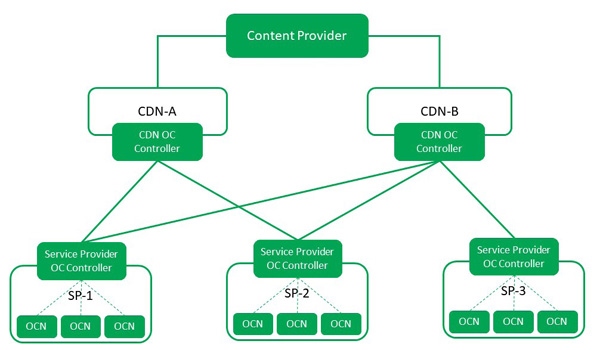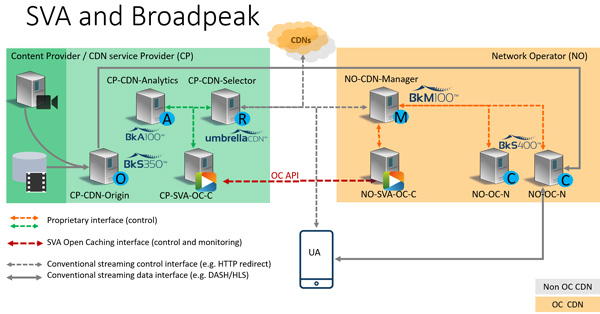
Broadpeak and ATEME are working toward optimising the relationship between content providers and network operators through Streaming Video Alliance Open Caching, which makes better use of existing infrastructure and limits the number of different CDNs operators need to manage. The goal is simpler local caching, less traffic across the network and a better video streaming QoE
Broadpeak, developer of CDN and video streaming systems for content providers and pay-TV operators, has successfully performed the first live demonstration of Streaming Video Alliance Open Caching APIs. Broadpeak showed an end-to-end workflow for SVA Open Caching, using its set of open APIs that standardises the interface between the hosted local cache infrastructure of an internet service provider (ISP), the party operating it and content providers. By moving hosted video caches as close as possible to end users’ terminals, local caching reduces traffic across a telecom operator’s core network and improves viewers' streaming experience.
Greater Reach, Less Infrastructure

from ATEME: ‘Open Caching: Why the Streaming Industry Can’t Afford to Ignore It’
“The Alliance exists to solve critical technical challenges facing online video delivery, with the ultimate aim of improving consumer adoption,” said Jason Thibeault, executive director of the Streaming Video Alliance. “By helping to standardise an interface for Streaming Video Alliance Open Caching, Broadpeak is taking a huge step toward optimising the relationship between content providers and network operators, and we’re excited about the positive impact this will have on the quality of experience for end users.”
Streaming Video Alliance Open Caching is a new approach to streaming that extends the reach of telecom operators, attracting more content providers to use their local caching infrastructure. With Streaming Video Alliance Open Caching, content providers can deliver a superior QoE to viewers by fully leveraging ISP infrastructures.
“Without a clear, common, simple API definition, it was difficult to drive further developments and conduct interoperable tests for Streaming Video Alliance Open Caching,” said Guillaume Bichot, principal engineer and head of exploration at Broadpeak. “Our team has taken a leading role in specifying this API, relying on the set of Alliance specifications, and converging the various options into a simple API that enables faster developments and interoperability. The success of this demo marks an important milestone for SVA Open Caching.”
The demo took place during the Streaming Video Alliance’s first 2021 quarterly meeting and was powered by a complete setup that included the video content source (an origin packager provided by a major content provider) and Broadpeak’s umbrellaCDN CDN selector on the client side, with Broadpeak’s BkM100 for CDN management and BkS400 local cache server on the ISP side.

Limiting CDN Management
ATEME, video delivery specialists for broadcast, cable TV, DTH, IPTV and OTT, also recognises the problems that managing several different CDNs within a network can cause service operators. ATEME wants customers to be able to take advantage of their own existing infrastructure, and has written a white paper on this topic titled ‘Open Caching: Why the Streaming Industry Can’t Afford to Ignore It’.
Open Caching enables operators to limit the number of cache servers in their network by limiting the number of different CDNs they have to deal with. Instead of maintaining a different CDN for each content provider, they can use a single Open Caching compliant system for all content providers, which will help maximise their infrastructure and reduce operational complexity.
In its white paper ATEME has said that the basic promise of Open Caching is interoperability, as it ensures that the same cache can be used by any Open Caching compliant system.
Open Cache Nodes
Still in its early days, the Open Caching approach allows content to be cached closer to the end user due to an Open Caching infrastructure established by local ISPs. Content providers and CDNs can then rely on this Open Caching infrastructure to delegate traffic to Open Caching compliant ISPs. In this way, Open Caching enables content providers and CDNs to extend their reach in new regions and markets more easily, without having to invest in more infrastructure, simply by accessing local Open Caching nodes hosted in ISP networks.

The Open Caching infrastructure is made up of three elements. Open Cache Nodes (OCNs) cache content near the end users and are owned by the ISPs. They can be used by any Open Caching compliant CDN to delegate traffic. Second, every CDN involved in the delivery chain requires a CDN Open Cache Controller (CDN OCC), which CDN uses to delegate its traffic to the OCN. Third, a Service Provider Open Cache Controller (SP OCC) serves as the interface between the CDN OCC and the service provider’s OCNs.
Open Caching brings together content providers, service providers, software companies and ISPs to better manage traffic, resulting in high quality experiences for end users, even during high viewing peaks. As well as helping ISPs to better manage spikes in traffic by keeping content closer to the end user, Open Caching helps content providers control the look and feel of their content. broadpeak.tv www.ateme.com




